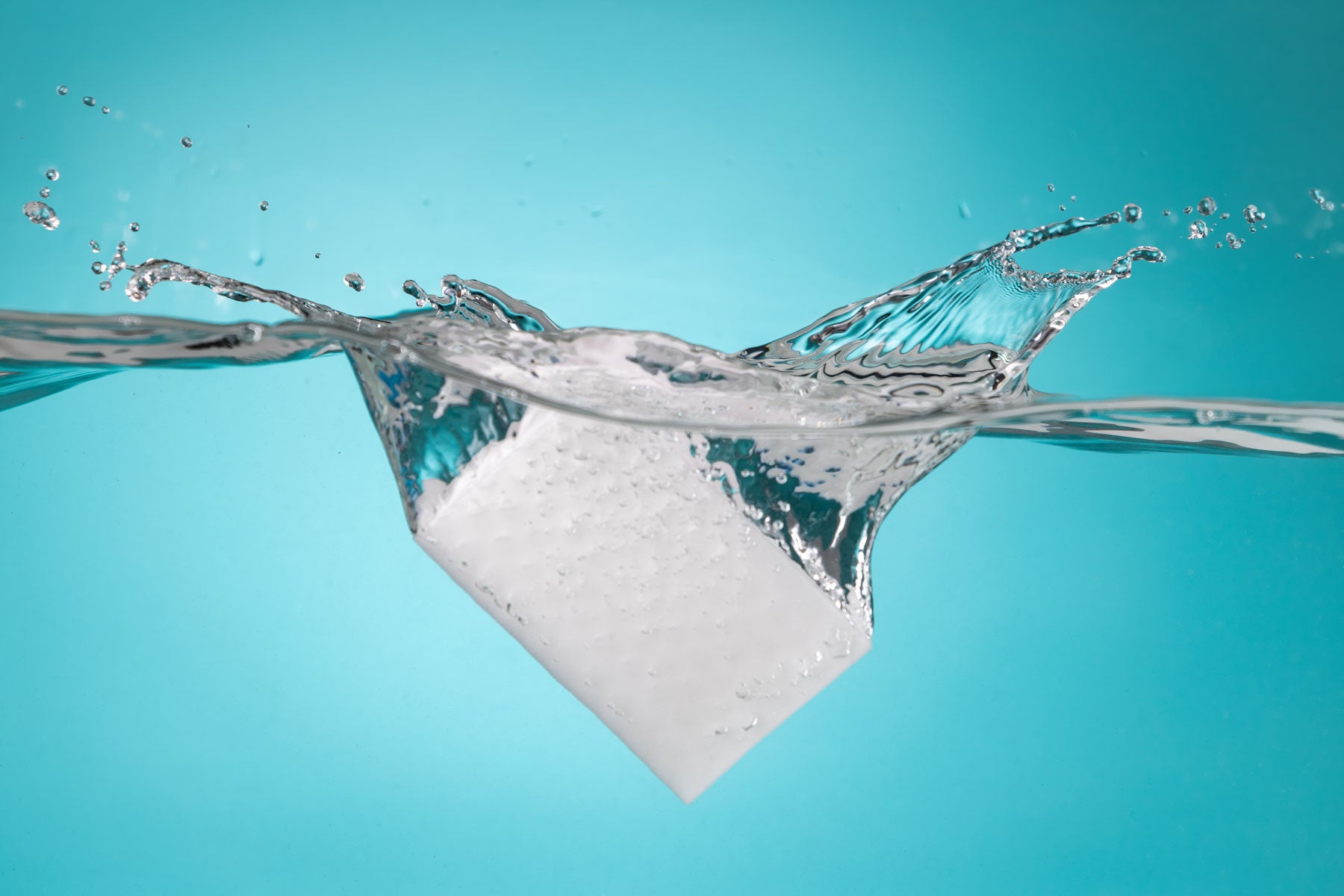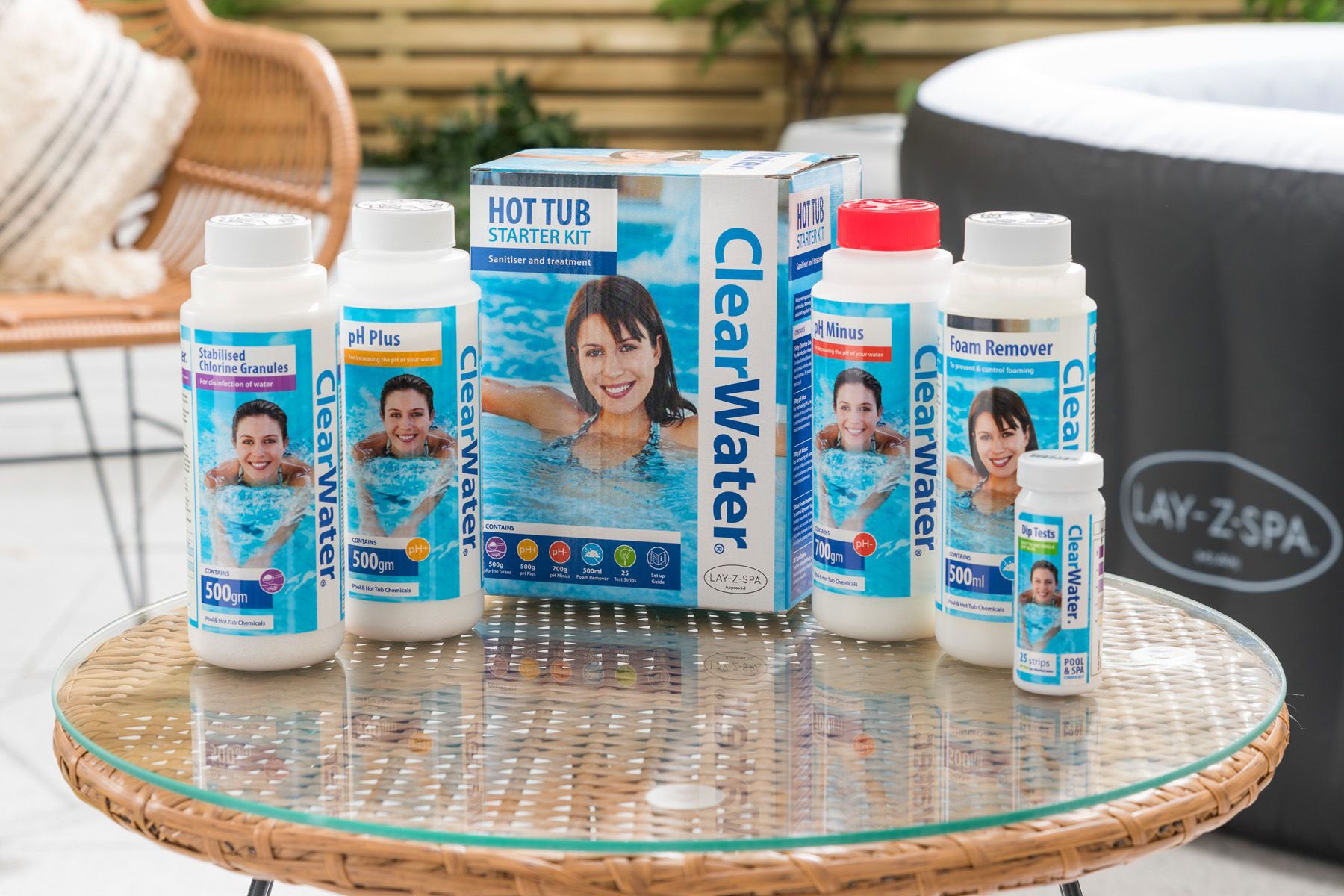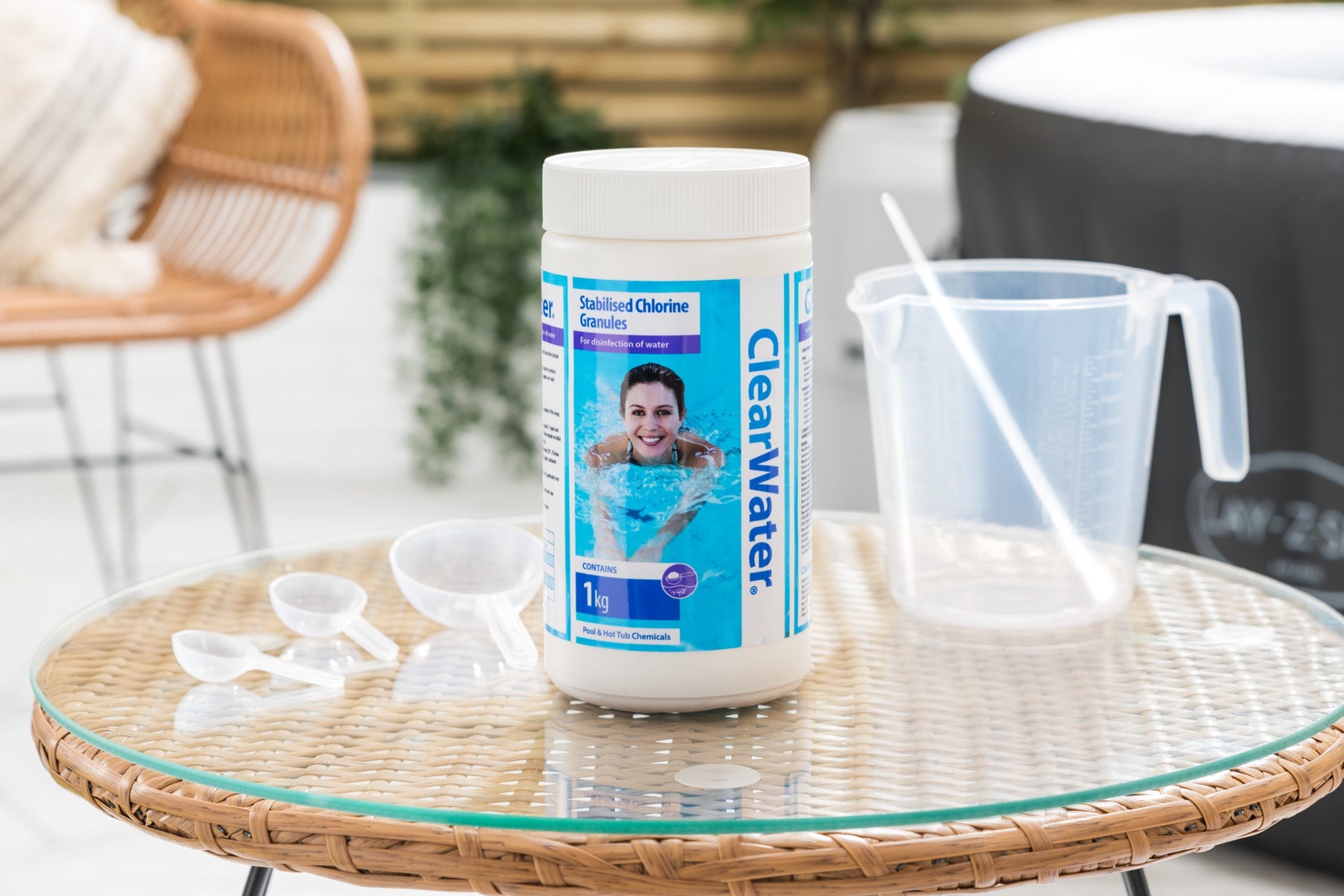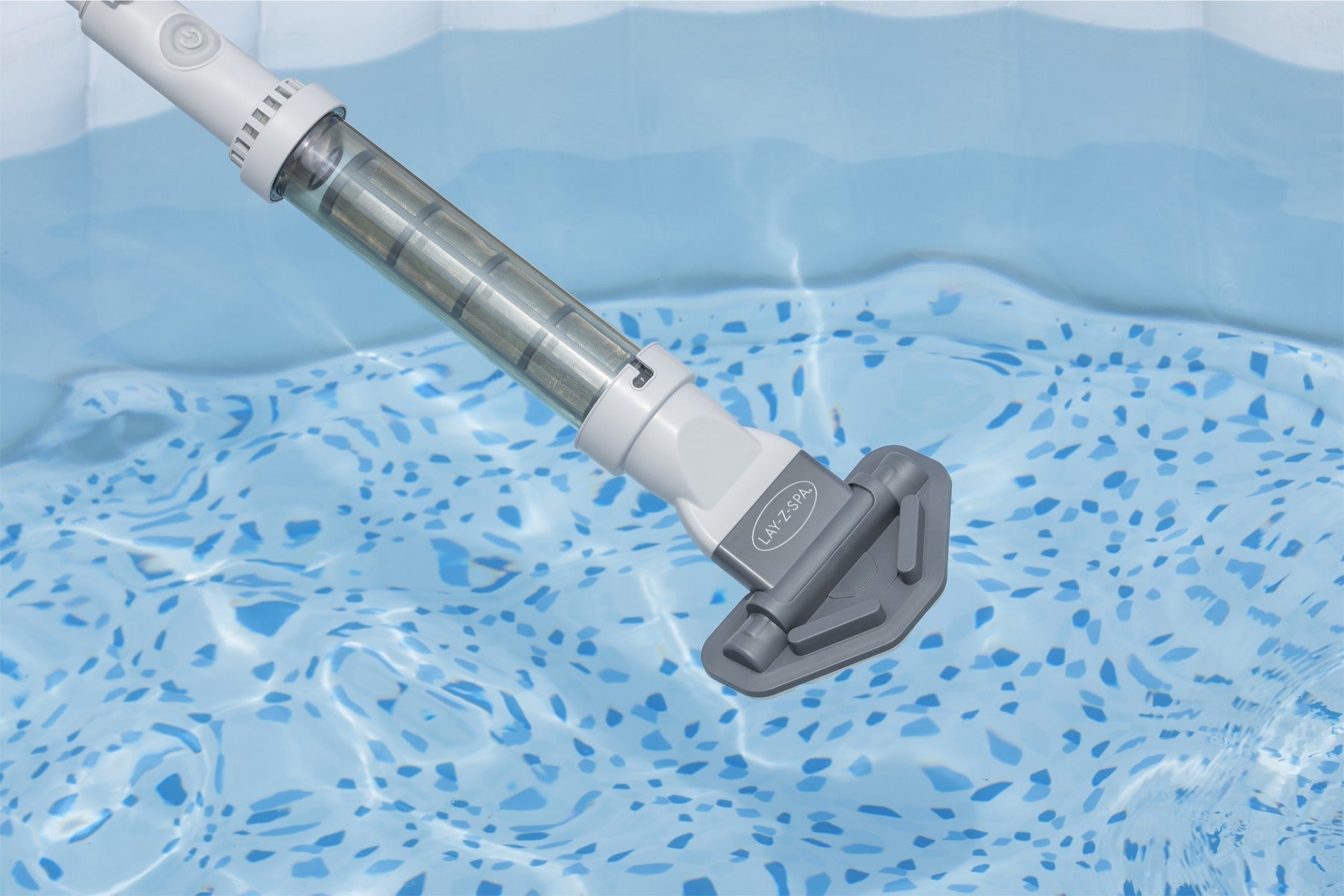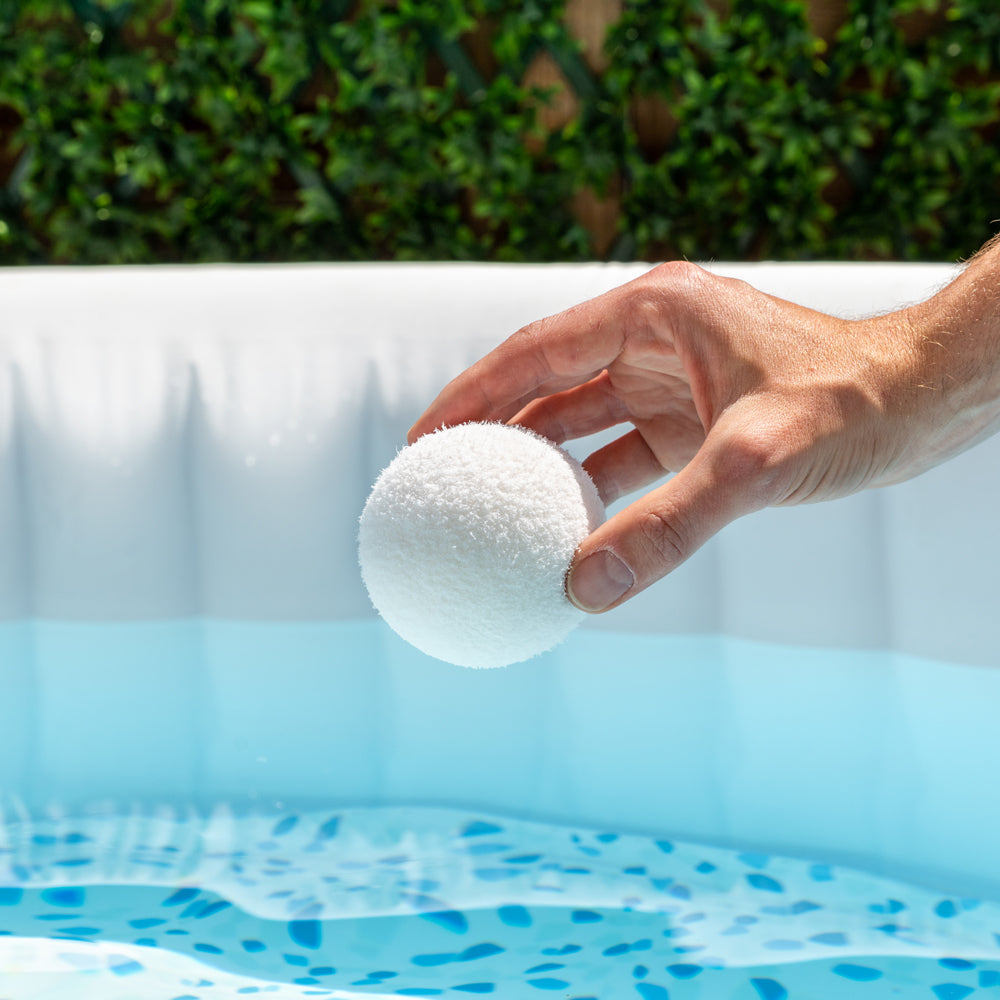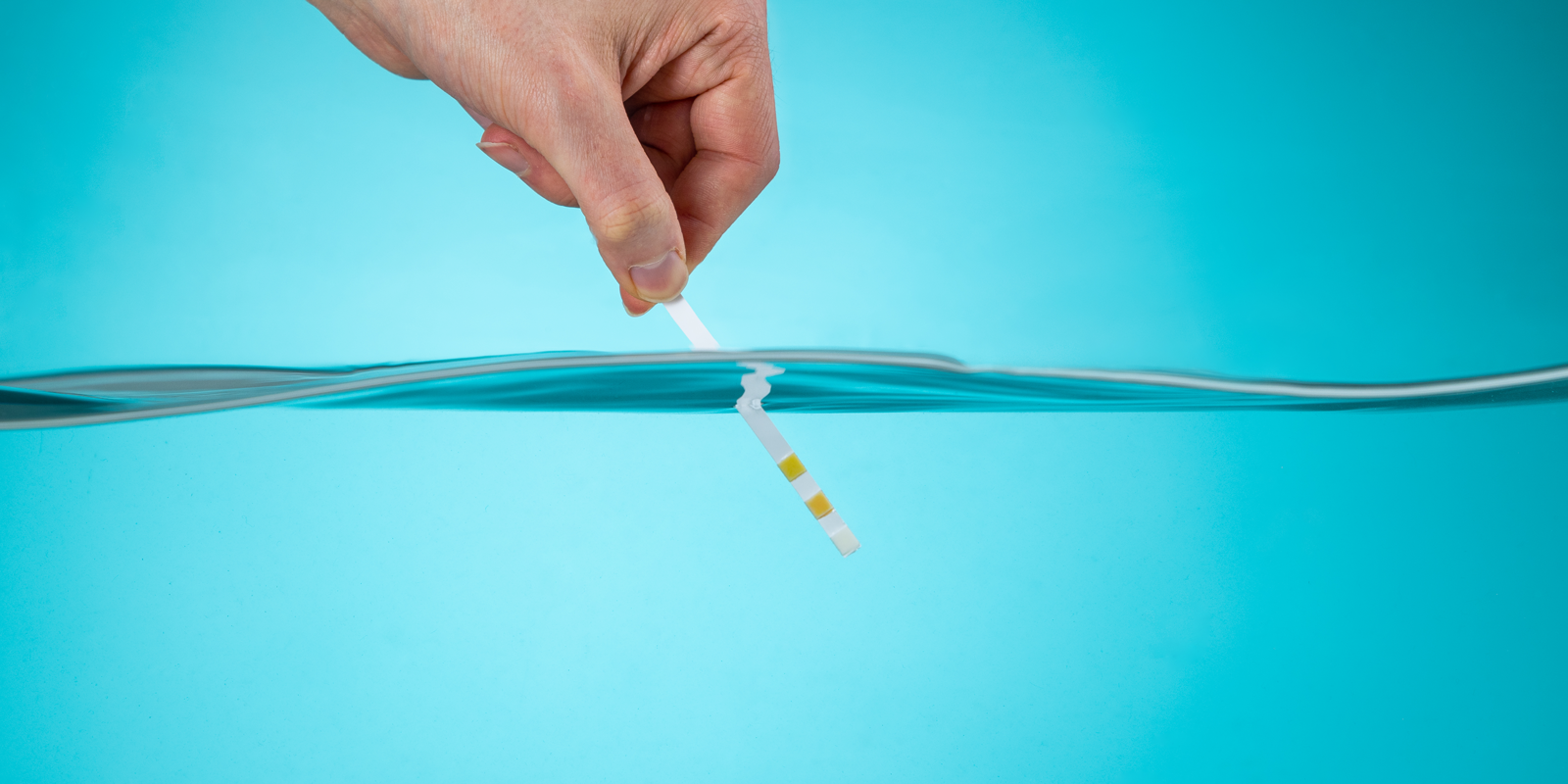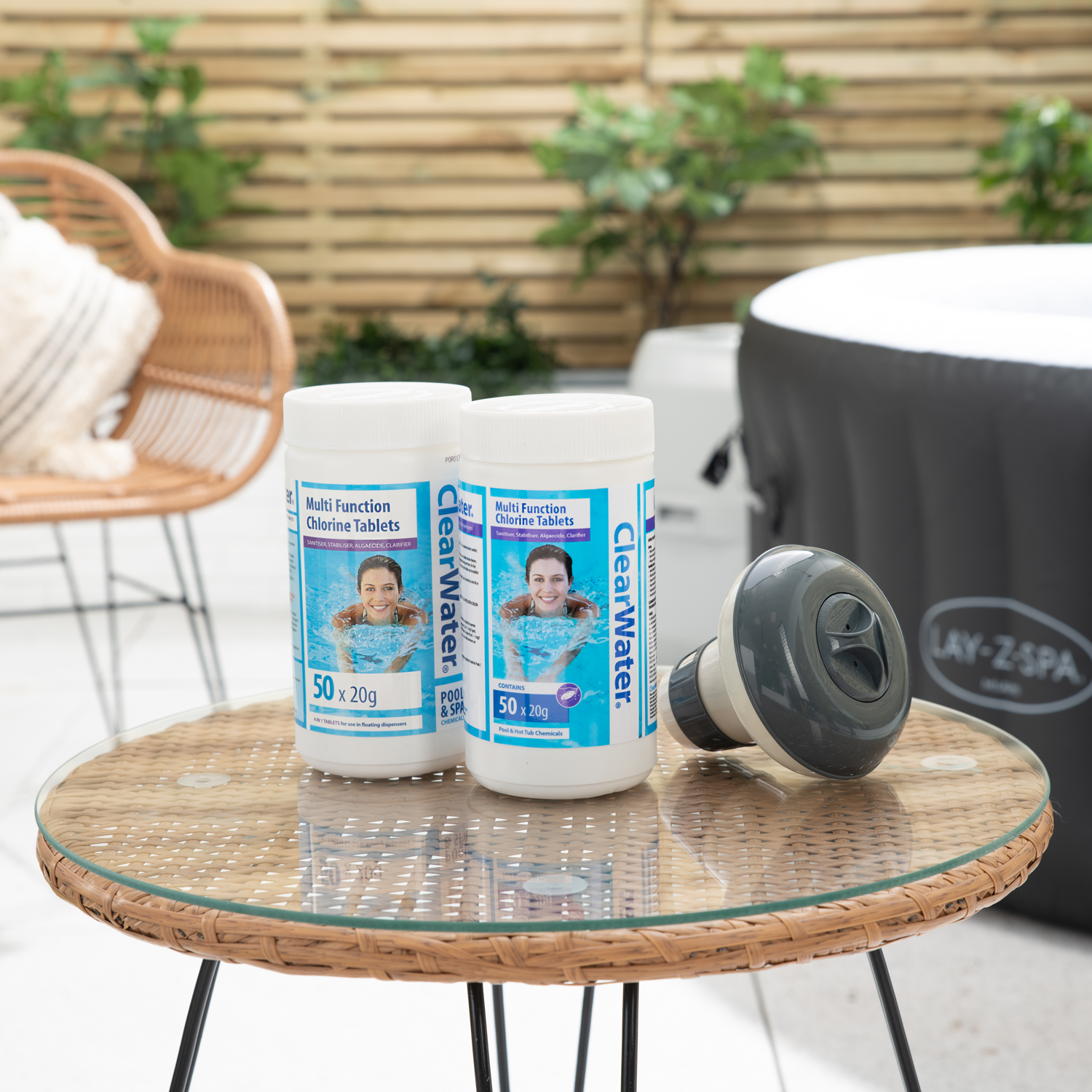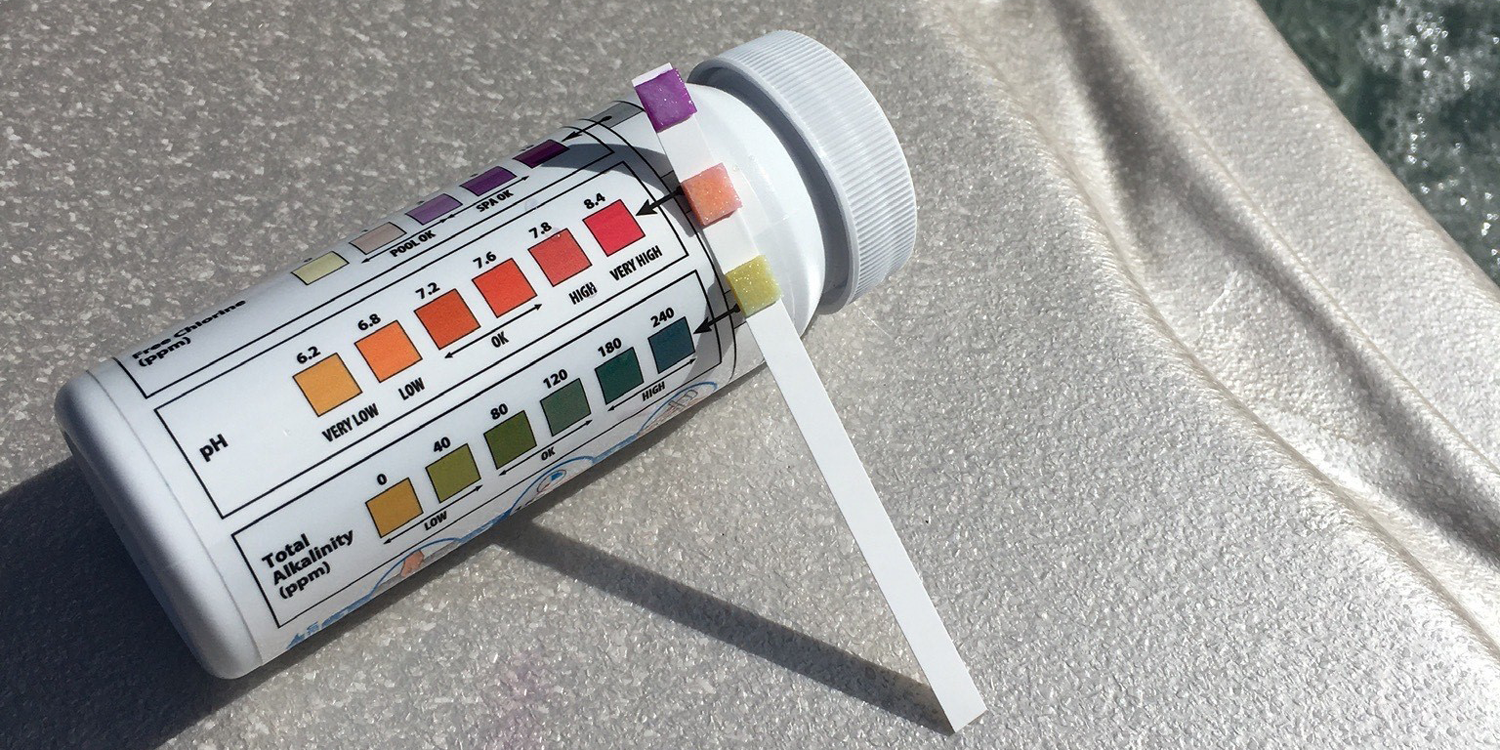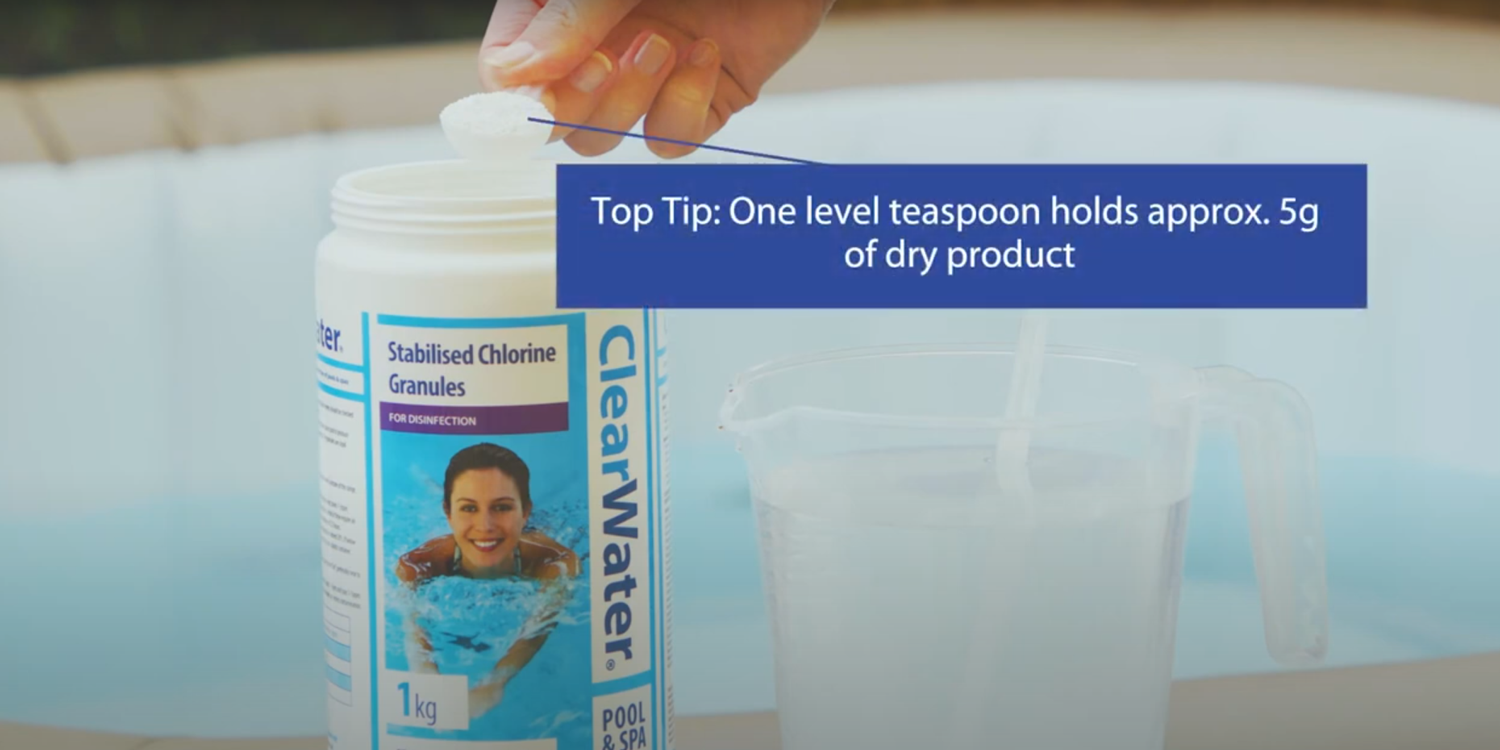Hot Tub Chemicals Guide
Hot Tub Quick Start Guide in 5 Easy Steps
Step 1: Shock Dose
Whenever fresh water is added to a hot tub (such as when you first fill up), you need to "shock dose" also known as a booster or hyperchlorination
Shock dosing means adding a high concentration of chlorine as this removes any bacteria or contamination.
You need to wait 24 hours after shock dosing your pool before moving on to the next steps.
Step 2. Test the water
Before using your hot tub, test the water and make sure the chemical balance reads as follows:
- Total Alkalinity - 80‑120 ppm
- pH levels - 7.2‑7.6
- Free Chlorine - 3-5 ppm
Step 3. Adjusting hot tub chemical levels
When you need to adjust your hot tub water's chemistry, do it in this order:
- Start with Total Alkalinity and aim for a reading of 80‑120 ppm. If the reading is low, add an alkalinity increaser, if it is high, use a pH reducer.
- Then look at the water's pH levels and aim for a reading of 7.2‑7.6. If the pH level is low, use a pH increaser and if it is high, use a pH reducer.
- Lastly is the Chlorine and you should aim for a reading of 3-5 ppm. Total Alkalinity and pH work hand‑in‑hand, and if these two are not balanced, the sanitiser (chlorine) will not work properly.
Please note: Allow at least 2 hours between adding each chemical type and only use the hot tub once your Total Alkalinity, pH and Chlorine levels are within the required ranges.
Step 4. Use the filter
The filter plays an important part in keeping your hot tub's water clean.
Refer to your hot tub manual to make sure you're running the filter for the required amount of time every day.
Regularly clean and replace the filter cartridges, and your water will stay cleaner for longer.
Step 5. Shower before using the hot tub
A quick shower before using a hot tub will help prevent cosmetics such as perfume, makeup and hair products from impacting the hot tub's chemical balance and water quality.
Swimwear should be washed in water, not detergents.
Hot Tub Water Chlorine "Shock Dose"
"Shock" Dosage GuideWhat is a hot tub "shock dose"?
Shock dosing a hot tub is adding a larger quantity of sanitiser, such as Chlorine, to break down organic matter, get rid of bacteria and any contaminants in the water, making it safe to use.
A shock dose can also help with any loss of water clarity or quality.
When do you shock dose a hot tub?
Hot tub water needs a shock dose treatment:
- When you first set up and fill up with fresh water
- After periods of heavy usage
- After a long period without use
- After a loss of water clarity or quality
- After refilling with fresh water
How to shock dose a hot tub
A hot tub shock needs Chlorine Granules. Chlorine tablets are slow-releasing and should only be used to maintain daily chlorine levels.
- Check the water capacity of your hot tub and measure the Chlorine Granules accordingly. The volume of water dictates how much chlorine you need to add.
- Do not add the granules straight into the water. Dissolve the right quantity of Chlorine Granules in a jug of warm water and pour into your hot tub. Activate the massage jets for a few minutes to circulate the chemicals evenly throughout the water.
- After shock dosing your hot tub, you will need to wait a minimum of 24 hours. Then, test the chlorine level with the dip test strips and make sure levels are 3‑5ppm. Add more Chlorine if necessary, but balance the pH and Total Alkalinity first.
Rough Guide:
- 12grams / 2 teaspoons for a 600 litre hot tub
- 16grams / 3 teaspoons for a 800 litre hot tub
- 20grams / 4 teaspoons for a 1000 litre hot tub
- 24grams / 5 teaspoons for a 1200 litre hot tub
Top Tip: A teaspoon holds approx. 5g of Stabilised Chlorine Granules.
Total Alkalinity (TA)
What is hot tub water Total Alkalinity?
Total Alkalinity (TA) is the measure of your hot tub water’s ability to neutralise acids. It acts as a buffer to neutralise pH.
If alkalinity is not balanced, pH levels can go up-and-down and chlorine levels are difficult to manage.
We always recommend balancing a hort tub's Total Alkalinity level before doing anything else.
Is hot tub water Total Alkalinity important?
Balanced Total Alkalinity helps control the pH levels of the hot tub water. They work together and help maintain stable chlorine levels.
If either Total Alkalinity or pH levels are off, you may notice a drop in water quality, cloudy water, itchy skin, and it could become corrosive to internal parts such as the heater pump, pipes and even the liner.
How to Balance Total Alkalinity in a Hot Tub
The correct level to aim for is between 80 and 120ppm (parts per million).
- For low TA levels below 80ppm you will need to use Total Alkalinity Increaser. The amount of TA + you need to add to your hot tub depends on the volume of water and how low your readings are. As a guide, 1,000 litres of water requires 18g to raise Total Alkalinity levels by 10 ppm (parts per million).
- For high TA levels above 120ppm you will need to use PH Minus. The amount of pH decreaser you need to add to your hot tub depends on levels are and on the volume of water. Check the dosage rates on the back of the bottle and measure accordingly.
Issues caused by high or low Alkalinity
Low Total Alkalinity:
- Irregular, low pH levels
- Corrosive
- Itchy skin & burning eyes
- Loss of water quality
High Total Alkalinity
- pH levels will be high
- Chlorine levels fluctuating
- Cloudy, milky foamy water
- Scale build-up
What causes high or low TA in a hot tub?
High TA can be caused by:
- Cosmetics, body lotions, make up etc
- Hard water with a high pH
- Water has been in too long and TDS* is high (*Total Dissolved Solids)
Low TA can be caused by:
- Rainwater
- Sweat
- Organic contaminants brought into the water by users.
pH Levels
pH Dosage GuideWhat is hot tub water pH?
pH measures how acidic or alkaline your water is and the ideal range for hot tubs is between 7.2 and 7.6.
Is pH important in a hot tub?
Balanced pH is necessary for other chemicals to work properly and imbalanced pH levels can impact your hot tub components and cause skin irritation.
How To balance pH levels in a hot tub
When testing hot tub water, aim for a reading of 7.2 and 7.6
- For low pH levels below 7.2 you will need to use pH Plus to help raise the pH levels and balance the water.
- For high pH levels above 7.6, use pH Minus to help bring those levels back down into the recommended range
The amount of pH increaser or decreaser you need to add to your hot tub depends on the volume of water and how low your readings are. Refer to the dosage information printed on the individual chemical bottles.
Issues caused by high or low pH
Low pH:
- Less effective chlorine
- Corrosive
- Dry skin & burning eyes
- Loss of water quality
High pH
- Skin & eye irritation
- Chlorine levels fluctuating
- Cloudy, milky foamy water
- Scale build-up
Chlorine
Chlorine Dosage GuideDo you need Chlorine in a hot tub?
Chlorine is a highly effective sanitiser that controls and prevents bacterial growth and is essential for the hot tub water to be clean and safe to use.
Without chlorine in a hot tub, the water will rapidly become cloudy, slime may start to form, and it could very quickly become unpleasant or unhealthy for users.
How much chlorine do I need for my hot tub?
The recommended Free Chlorine* level in a hot tub is 3‑5ppm (parts per million).
Click on the Chlorine dosage guide for recommended amounts.
Top Tip: A teaspoon holds approx. 5g of Stabilised Chlorine Granules.
*Free Chlorine refers to the amount of chlorine in your hot tub that is available to sanitise or disinfect the water, keeping it safe for users.
Do I need to add chlorine to my hot tub every day?
The rate of chlorine consumption depends on different individual circumstances, and chlorine will be consumed even when the hot tub is not being used (i.e. by sunlight or contaminants).
Some hot tub owners add a measure of chlorine immediately after using the hot tub, while others test the water a few hours before they want to use it.
The only way to be sure that there is sufficient chlorine present in the pool water is to test regularly.
Low hot tub chlorine: what to do
When hot tub chlorine falls below 3ppm there is a risk of bacteria growing and a quick loss of water quality.
You will need to add the appropriate amount of chlorine to restore the balance.
Your options are:
- Chlorine granules - the most accurate way of raising chlorine levels in a short space of time, including a shock dose
- Chlorine tablets - these are slow release, so could take some time to raise Free Chlorine ppm if it is very low.
- Fast Action Tablets - These go straight into the water and a great for a quick boost of chlorine as they dissolve in 30 minutes.
Low chlorine levels:
- Loss of water quality
- Cloudy water
- Bacteria growth
- Bad smell
- Bio film
High chlorine: what to do
For high chlorine levels above 5ppm, we strongly recommend not using your hot tub as it could likely cause irritation.
We would suggest you drain some of the water from your hot tub and re‑fill with fresh water. This will help to dilute the excess chemical.
High chlorine levels:
- Itchy skin & burning eyes
- Corrosive
- Discolouration
Hot Tub Chemicals & What They Do
Explore this complete list of all the different ClearWater® hot tub chemicals. Find out what they do and how they can help with your water maintenance.
Shop ClearWater® Hot Tub ChemicalsThis spray is designed for use on PVC/vinyl material to help keep your hot tub clean and free from stains.
Its chemical formula will not affect the chemical balance of your water if you accidently spray some in the water.
ClearWater Chlorine Granules are one of our most popular products and are considered an essential item in every hot tub owner’s tool kit.
Chlorine granules disinfect hot tub water by killing off bacteria and any contaminants.
When water becomes a bit cloudy, Clearwater Clarifier helps to restore clear water.
A clarifier contains flocculants that bind small particles of debris together so they get caught in the filter.
These small fast dissolving tablets can be added straight into the water for a quick and effective chlorine boost.
This liquid is perfect for cleaning hot tub filters and keeping them in the best condition for longer.
Clearwater Foam Remover is designed to control and prevent foaming in your hot tub.
Foam is typically caused by the reaction of water with shampoos, deodorants, detergents on swimwear and natural body oils.
Clearwater Multifunction Tablets are an effective and hassle‑free way of maintaining clear and healthy water.
These slow‑release tablets contain chlorine, algaecide and water clarifier. Add these to the ChemConnect® or a floating dispenser to slowly release into the water.
ClearWater pH Plus, also known as ‘pH increaser’ is the best way to increase pH levels that have dropped below the recommended level.
To avoid skin discomforts, water issues and enable the chlorine in your hot tub to work effectively, it’s vital that pH levels are correct. The recommended pH balance of a hot tub water is between 7.2 and 7.6.
ClearWater pH Minus, also known as ‘pH reducer’ is the most simple and effective way to decrease the pH of your hot tub water when it it is too high.
pH minus can also be used to lower TA (Total Alkalinity) levels.
As with pH Minus, it’s vital that pH levels are correct. The recommended pH balance of a hot tub water is between 7.2 and 7.6.
Clearwater Scale and Stain Controller is highly recommended for regular use in hard water areas.
This TA Increaser helps raise Total Alkalinity levels, which in turn will help control steady pH levels and chlorine.
Hot Tub Chemical FAQs
What chemicals do I need for my Hot Tub?
Sanitising hot tub water is crucial to remove bacteria and contaminants. For this, we recommend Chlorine.
Balanced water chemistry takes into account the alkalinity and pH of your water, so you may require pH Minus, pH Plus and TA Plus.
Other hot tub chemicals are classed as non-essential but may be required in certain circumstances.
For beginners, we suggest getting the ClearWater® Hot Tub Starter Kit. This includes the basics to get started and it might be all you need.
Do I need to put chemicals in my Hot Tub every day?
The short answer is no.
Factors such as heavy use, how clean the bather are and seasonal environment, some chemical levels may change more than others but it is generally a case of periodically making minor adjustments, such as adding some chlorine.
Our advice is to test the water a few hours before you want to use your hot tub and making necessary adjustments, if any are needed.
How much do I need to put in my hot tub?
Scroll back up this page and you will find recommended dosage and advice for the essential hot tub chemicals.
All ClearWater® hot tub chemicals include dosage recommendations on the packaging.
In what order do I adjust Hot Tub chemicals?
After an initial shock dose, the correct order to manage and balance hot tub chemicals is:
- Total Alkalinity (80‑120 ppm)
- pH levels (7.2‑7.6)
- Chlorine (3‑5ppm)
Storage & Handling
Hot Tub Chemicals Handling
- Read instructions thoroughly on each product/box before use.
- When pre-dissolving chemicals, always add chemicals to water and not vice versa.
- Never mix different chemicals in concentrated forms. This includes kit products but also with other chemicals like bleach or weedkillers – a dangerous reaction may occur.
- Always pre-dissolve chemicals in a clean, plastic container in a well-ventilated area.
- Avoid spillages. In the event of spillage, clean up using clean receptacles and dispose of them carefully.
- Wash hands after handling hot tub chemicals
Hot tub chemicals storage
- Store chemicals well away from children and pets
- Store in a secure, cool and dry place
- Store chemicals in original packaging and never use unlabelled chemicals



